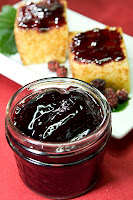Sometimes the abundance of a seasonal harvest of wild foods overwhelms us, and we are not able to eat all we gather at once. Sometimes I crave the iron-y taste of nettles in December, wineberries in my oatmeal in February, or a rich, wild mushroom stew in the spring. To preserve the harvest, we use several methods of keeping wild food to use at later dates. Freezing is a method of preservation we use on many different types of wild food, from greens to berries, mushrooms, and dried flours. Several years ago we purchased a small chest freezer to keep in the basement just to fill with foraged foods, and I keep an up-to-date inventory on my fridge so I can remember what we have.

Keeping wild greens in the freezer can be accomplished in a couple of ways. In the spring when everyone has ramps fever, we head out to our favorite patches for the harvest. We rarely dig the bulb of the ramp plant, instead we harvest the green leaves by using scissors and snipping one leaf from each cluster of 2-4 leaves. Two ways we freeze them are by making the greens into a
ramps pesto and freezing it in small containers, or by finely slicing the greens into strips (called a "chiffonade") and tightly packing them into containers. The ramps greens keep well this way, and I just have to pull out a bit to use them in soups, bagels, or any recipe where they will be cooked.
 |
| nettles |
Leafy greens also keep well in the freezer, but they need a bit of preparation first. We freeze nettles, dandelions, and garlic mustard greens in thin bricks, that way I am able to break off a bit to use when I am cooking. Before we freeze the greens, we blanch then for about 15 seconds in boiling water, then shock the greens in ice water. This stops the cooking process and allows the greens to keep their color and nutritional content, while removing most of the volume of the raw greens. After the greens are cooled, I wring out the excess water by squeezing them in handfuls, give the greens a quick and coarse chop, then tightly pack a thin layer of greens in a freezer-safe gallon plastic bag. I try to freeze the bags flat on their sides, and once they are frozen, they are easily stacked or placed upright.
 |
| July abundance of wineberries and wild blueberries |
 |
| cranberries, cleaned and ready for freezing |
Berries also freeze well, with a little planning. I try to Individually Quick Freeze them, or use the IQF method. We keep wineberries, blackberries, cranberries, blueberries, and non-traditional berries like spicebush berries in the freezer. To prepare berries for the freezer, I generally give them a quick wash and allow them to air-dry. I then spread them on a single layer on a parchment paper-lined sheet pan, and put the pan in the freezer. As long as they are not wet, they will freeze individually and can then be scooped into quart-sized freezer bags. I try to remove as much air as possible from the bag to prevent ice crystals from forming, and use the berries before the next season comes around. While the berries will be a little soft upon thawing, they can still be used successfully in oatmeal, pancakes, juiced, and in recipes like muffins and pancakes.
 |
| A large maitake mushroom |
It is not often we are able to find so many mushrooms that we need to freeze them, but the 3 of us can only eat so much of the larger specimens at a time. Some maitake can weigh up to 30 pounds, and often we find more than one, so freezing is one way to preserve our harvest. We also freeze honey mushrooms and sulphur shelf mushrooms. To freeze mushrooms, you can either slice and pack them into containers raw, or cook them first and freeze. I generally pack them raw, as the freezing and thawing process makes the mushroom release a lot of its liquid, which I can then reduce and concentrate while cooking with the fungi. I use the frozen mushrooms in soups and in pilafs, and stuff bread with the cooked mushrooms. We also made large amounts of ravioli and burger patties with the fresh mushrooms, and froze them in plastic bags.
 |
| Acorn flour, stored in glass jars in the freezer, will last for a couple years |
Some of the more unusual things we keep in the freezer are acorn flour (to keep it from going rancid), nuts like hickory and black walnut, pine and cattail pollen, dried and powdered nettles, and the male portion of cattail flowers, removed from the stem. I also keep a batch of Japanese knotweed muffins and berry juice, usually surplus from jam making. There is a small container of garlic mustard seeds in the freezer as well, to use in mustard making and to sprinkle on breads. Having our abundant harvests of wild food on hand all year in the freezer enhances our meals, and reduces our grocery bill at the same time!





































